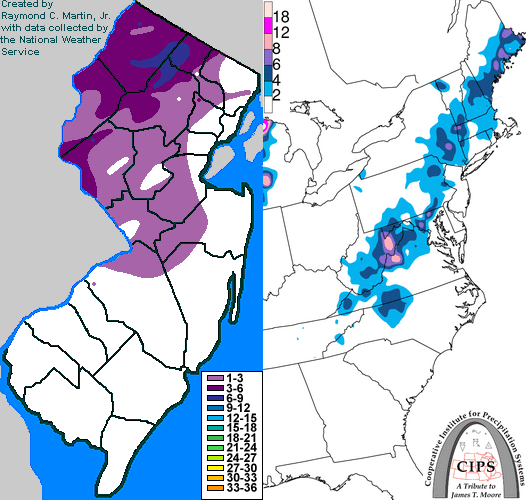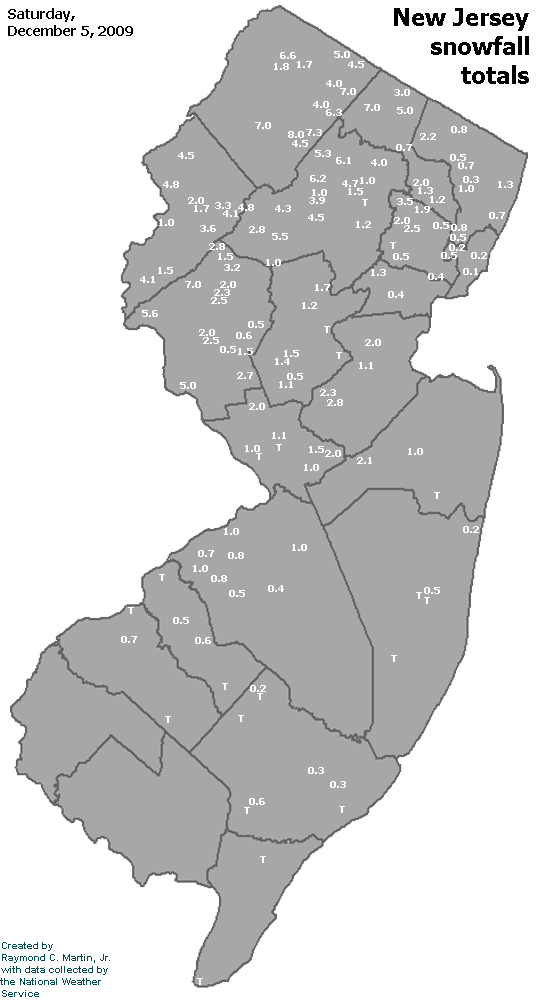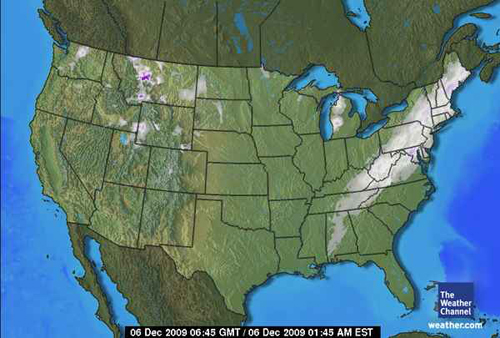

Storm description, surface observations, snowfall totals, and images courtesy of the National Climatic Data Center, the National Centers of Environmental Prediction, the Climate Prediction Center, the Hydrometeorological Prediction Center, the Mount Holly National Weather Service Office, the Upton National Weather Service Office, Rutgers University, Plymouth State University, the University of Illinois, the American Meteorological Society, Weather Graphics Technologies, AccuWeather, and the Weather Channel.
Table of Contents
Storm Summary
Regional Surface Observations
National Weather Service Forecasts
Surface Maps
Satellite Imagery
National Surface Weather Maps - Pressure and Fronts Only
Continental Surface Weather Maps - Pressure and Fronts Only
Sea Level Pressure and 1000 to 500 Millibar Thickness Maps
850 Millibar Maps
700 Millibar Maps
500 Millibar Maps
300 Millibar Maps
200 Millibar Maps
National Radar Imagery
Regional Radar Imagery
Fort Dix Doppler Radar Imagery

Contoured Snowfall Totals from December 5, 2009
STORM DESCRIPTION
A wave of low pressure brought the first accumulating snowfall of the season to much of New Jersey.
Synoptic Discussion
A cold front moved through New Jersey early on December 3rd. The front then stalled off the Southeast coast by the morning of December 4th. Early on December 5th, a low pressure began to develop along the front near the Carolina coast. The low then moved rapidly northeastward, moving just east of Nova Scotia during the early morning hours of December 6th.
Local Discussion
Precpitation associated with the low pressure system overspread New Jersey during the late morning and early afternoon of December 5th. Surface temperatures were mostly in the lower 40s as precipitation began, so in most places it started in the form of rain. The exception was the northwestern corner of the state, where the air was dry enough such that evaporational cooling took place at the onset and the precipitation started as snow. As temperatures gradually dropped through the 30s during the afternoon of December 5th, the rain gradually turned to snow from northwest to southeast before ending from west to east during the mid to late evening. Snowfall accumulations were greatest in the higher elevations of northern New Jersey and rapidly decreased with elevation and lattitude. Totals ranged from 1 to 7 inches in Sussex, Hunterdon and Passaic counties, 1 to 5 inches in Warren and Morris counties, a coating to 3 inches in Bergen and Essex counties, a coating to 2 inches in Union, Somerset, Middlesex, Mercer and Monmouth counties, a coating to 1 inch in Burlington County, and less than 1 inch in Hudson, Ocean, Atlantic, Camden, Gloucester, Salem, Cumberland and Cape May counties.
New Jersey Snowfall Totals

Individual Snowfall Totals from December 5, 2009
Regional Snowfall Totals

Snowfall Totals from December 5, 2009
Table of Contents
Storm Summary
Regional Surface Observations
National Weather Service Forecasts
Surface Maps
Satellite Imagery
National Surface Weather Maps - Pressure and Fronts Only
Continental Surface Weather Maps - Pressure and Fronts Only
Sea Level Pressure and 1000 to 500 Millibar Thickness Maps
850 Millibar Maps
700 Millibar Maps
500 Millibar Maps
300 Millibar Maps
200 Millibar Maps
National Radar Imagery
Regional Radar Imagery
Fort Dix Doppler Radar Imagery
Snow storm, December 5, 2009
Snow storm, December 19-20, 2009
Snow storm, December 31, 2009
Snow storm, February 2-3, 2010
Snow storm, February 5-6, 2010
Snow storm, February 9-11, 2010
Snow storm, February 15-16, 2010
Snow storm, February 25-26, 2010
Back to Ray's Winter Storm Archive
Copyright © 2012 by Raymond C Martin Jr. All rights reserved